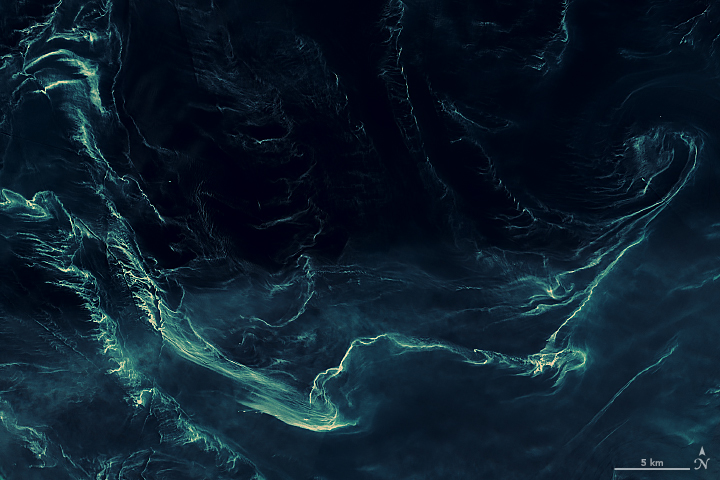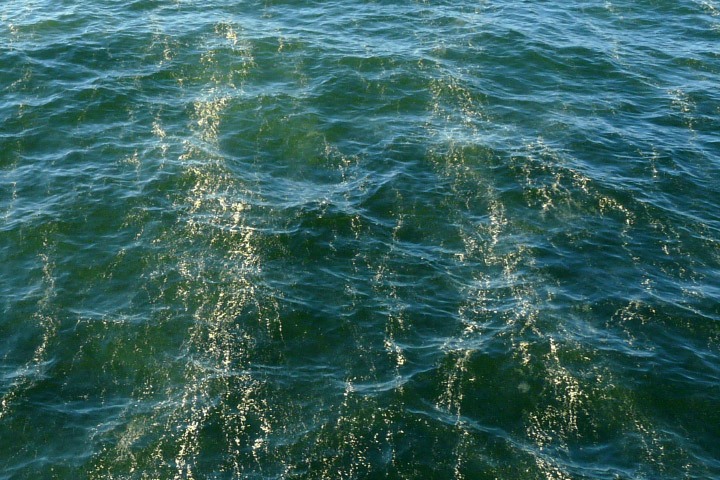

Seasonal allergy sufferers be warned: this story may have you reaching for the antihistamines. Researchers have determined that “slicks” on the surface of the Baltic Sea, visible in satellite images, are made up of pine pollen.
Pollen slicks are visible in these images of the Baltic Sea, acquired on May 16, 2018, with the MultiSpectral Instrument (MSI) on the European Space Agency’s Sentinel-2A satellite. The images are false-color (bands 8A, 3, and 2) and have been enhanced to increase the visibility of the pollen. The patterns are caused by wind-driven currents and waves moving the pollen around on the surface of the water.

The composition of slicks in this region was previously unclear. Other types of floating material, such as cyanobacteria and marine debris, have been known to appear in satellite imagery. But by combining experimental results, ground-based observations, and satellite image processing, the researchers could confidently attribute the material in the eddies to pine (Pinus sylvestris) pollen.
The impetus for investigating this phenomenon came from a different marine event, said Chuanmin Hu, an ocean optics expert at the University of South Florida who led the research. “This work is inspired by a recent sea snot event in the Marmara Sea that created a huge problem for Türkiye and its coastal regions,” he said. Sea snot, which is caused by phytoplankton releasing a gooey substance, coated large swaths of the sea in May 2021 and caught Hu’s attention when it was detected by satellites.
That led him to wonder if anything comparable was occurring on other large bodies of water nearby. As it turned out, satellite images of the Baltic Sea from that time looked similar to the satellite images of sea snot in the Marmara Sea (to human eyes, at least). But Hu found it strange that there were no reports of disruptive slime from the large, heavily trafficked sea.
To identify potential slicks, Hu and colleagues inspected medium-resolution satellite images from sensors such as the Moderate Resolution Imaging Spectroradiometer on NASA’s Terra and Aqua satellites. When his team analyzed other satellite data for the spectral signature of the mystery Baltic Sea substance, they realized it was distinct from sea snot and other floating matter. The spectral shape had a characteristically sharp increase between wavelengths of 400 and 500 nanometers.
Given the timing of the slicks and the prevalence of pine trees in the nine countries surrounding the sea, they suspected pollen as a possible culprit. Collaborators in Poland had photographs of pollen on the surface of the water, acquired during fieldwork in May 2013 (below). To dig deeper, the U.S. and Polish groups conducted laboratory and field experiments to measure the spectral reflectance of pollen. Indeed, the results matched what was captured by satellites.

The researchers then looked back at springtime images of the Baltic Sea from 2000 to 2021 and saw similar slick patterns in 14 of those years. Notably, the pollen’s footprint on the sea in the second half of the study period was markedly larger than in the first half. In recent years, slicks often cover some portion of the sea in parts of May and June.
This observation aligns with trends toward longer pollen seasons and more pollen production that have been documented in other areas of the world. For example, one recent study found that pollen season in North America starts nearly three weeks sooner and lasts about a week longer than it did in 1990, driven by warming temperatures. In addition, more carbon dioxide in the atmosphere fueling photosynthesis may increase plants’ potential to produce more pollen.
The profusion of pollen may have larger impacts beyond making people sneeze. Though not well studied, pollen grains can affect aquatic ecosystems by supplying carbon to the sea. Much like leaf litter supports food webs in lakes and streams, pollen grains may be an important source of nutrients for insect larvae, crustaceans, and other invertebrates in coastal Baltic Sea waters.
Having cracked the code of distinguishing pollen in satellite imagery, Hu thinks the imagery may lead to several new insights. “If we can track pollen aggregation in different places, this may provide useful data for fisheries studies,” he said. Even more, the technique could complement land-based air quality sensors to monitor allergens—all the more relevant as human health impacts from allergies intensify.
NASA Earth Observatory images by Lauren Dauphin, using modified Copernicus Sentinel data (2023) processed by the European Space Agency. Photograph courtesy of Magdalena Pawlik and Dariusz Ficek. Story by Lindsey Doermann.